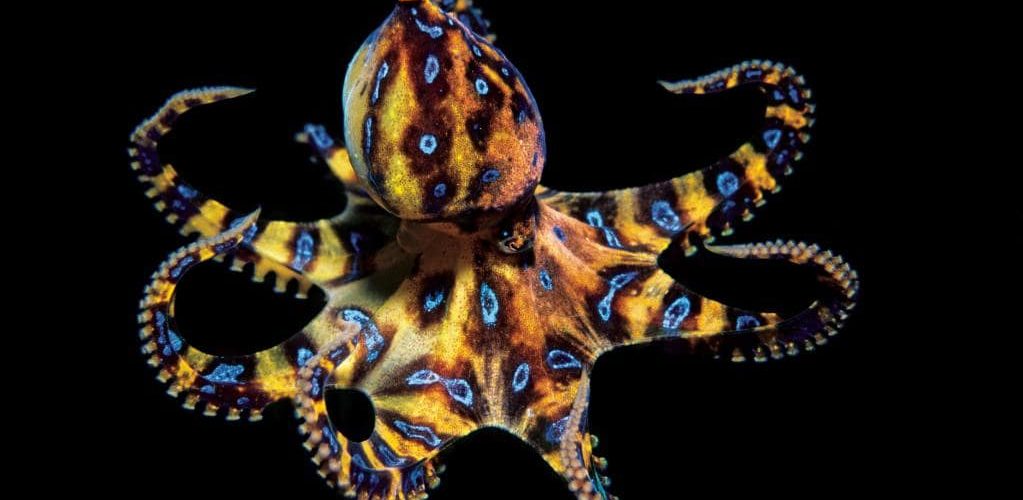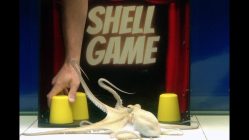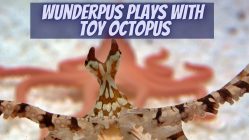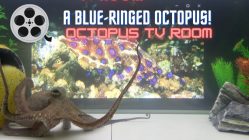There is something about the octopus that captivates the attention of young and old alike. Their eyes, their eight arms, the way that they can “walk” along the ocean floor or how they use jets of water to speed through the ocean — the octopus never ceizes to amaze.
There are over 300 species of octopus. They come in a range of sizes. The biggest can weigh as much as 35 pounds and have an arm span of 15 feet. The largest octopus ever recorder belonged to the Giant Pacific Octopus species and weighed in at 600 pounds with an arm span of over 30 feet.
With stories like that, it is not surprising that in movies, books, and pop culture, many people envision every octopus as being large. The reality is that most species are smaller — much smaller.
— Common Octopus — Octopus Vulgaris —
The Common Octopus, as its name implies, is one of the most common species of octopus. Its shape, arm dimensions, and form are what most people would immediately associate with an octopus.
In terms of size — depending on the specific region of where it resides, local food availability, etc. — the Common Octopus can have an arm span as large as three feet but most specimens top out at an arm span of barely one or two feet.
Here’s a video of one of our little octopuses deciding which den she prefers.
If you like the “classical” look for an octopus, you are going to love the smaller Octopus Vulgaris.
— The Bimac Octopus — Octopus Bimaculoides —
The Octopus Bimaculoides, better known to its admires as the “Bimac” or “Two-Spot” octopus has an arm span that is just below two feet when fully grown.
Small enough to be comfortable in a larger aquarium (50-gallons) and friendly, the Bimac is definitely a favorite. Some Bimacs have been known to play with Legos or to enjoy being fed from a stick.
— Blue-Ringed Octopus —
The Blue-Ringed Octopus is stunningly beautiful. Its body is adorned with multiple blue rings. Not quite the Hawaiian shirt look, but very close.
The Blue-Ringed Octopus has a length of five to eight inches. Its small size and festive coloration make it stunningly beautiful, however, it also happens to be extremely poisonous. It is a good thing that its nature is to be very mild-mannered and is only aggressive when it perceives a threat.
Another unique feature about the Blue-Ringed Octopus is that it is inkless. The majority of octopi species produce ink and use it as a defensive tool or to confuse prey. Perhaps it is the potency of its venom that makes ink unnecessary. In spite of its lethal punch of toxin, the Blue-Ringed Octopus can be found in the aquariums of some enthusiasts. Others, may prefer to adore it from afar.
— Dumbo Octopus — Octopus Grimpoteuthis —
The Dumbo Octopus measures 8 to 12 inches in length although some specimens have reached a size of six feet in length. For the most part, however, the Dumbo octopus is characterized as a small octopus.
Its popular name derives not from an attempt to deride its intelligence but to honor it. Like all octopi, this species displays signs of great intelligence. Its name comes as a form of flattery for its appearance. Some have even called the Dumbo Octopus the cutest octopus species of them all.
The Dumbo Octopus has two large fins on the sides of its head that in the water resemble large flapping ears. Its head is umbrella-like and its arms are usually shorter in length than its head. This gives this little guy the appearance of a little pink elephant swimming through the water. Now do you see how it earned its popular moniker? Don’t worry, Disney does not hold rights to the species.
These little fellows are not so easily spotted because they prefer dwelling in very deep water. They thrive in depths deeper than 10,000 feet.
— The Male Blanket Octopus — Tremoctopus Violaceus —
The Blanket Octopus is unique for many reasons. One of these being the huge size disparity between males and females of the species. Females can reach a length of six feet while males rarely grow beyond one inch in length. Yes, the female can be as much as 72 times larger than the male, although 36 times is more the norm.
The females deservedly are categorized as medium to large octopi while the male, for obvious reasons, is welcomed into the small octopus club. This species has webbing between their arms which makes them look like a blanket or rubber sheet when their arms are stretched out.
— Atlantic Pygmy Octopus —
The Atlantic Pygmy Octopus is often misclassified by some as the smallest octopus species. It measures 1.5 to 1.8 inches in length — that’s small, just not small enough to be the smallest.
It lives near the shore and has a “classical” octopus shape in terms of the proportion and shape of its head and arms.
— Octopus Wolfi —
When it comes to winning the title for the world’s smallest octopus species, that honor goes to the Octopus Wolfi.
Rarely growing more than one inch in length, this little guy ranks high in the cuteness factor. Being as small as it is, the Octopus Wolfi might seem ideal for even the smallest of home aquariums. However, its extreme smallness also earns it a high “escape risk” rating. Unless special precautions are taken, studies have indicated that these little guys have a better than 60 percent probability for successfully getting out of their tank.
Remember, all octopi are excellent escape artists, with even larger 25-pound species managing to squeeze through openings no more than three inches in diameter. That being the case, imagine all of the ways that an octopus measuring less than one inch in length could pull off an “El Chapo” maneuver and flee.
— At Any Scale, Octopuses Are Fantastic —
Whether you admire the biggest octopi in the ocean or their smaller cousins, they all have admiring qualities in common. They are smart and resourceful creatures which shed light on how varied animal intelligence truly is. The more we observe and study them the more they manage to impress us.




















